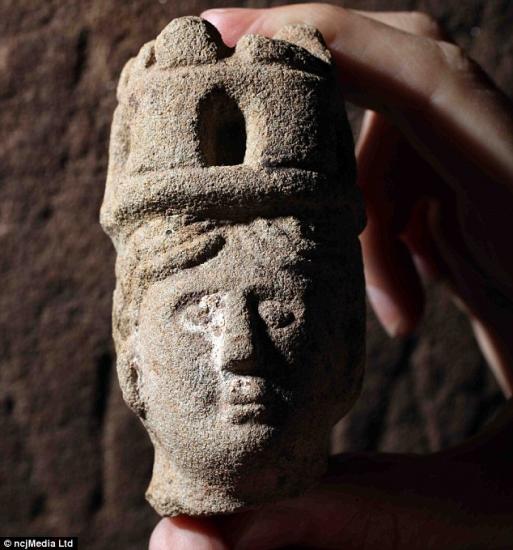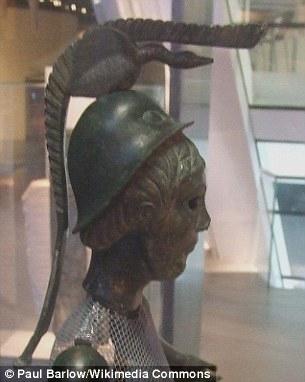Finely carved stone head depicts ancient idol Brigantia
Victoria Woollaston
Source - http://www.dailymail.co.uk/sciencetech/article-2784990/Face-Roman-goddess-unearthed-time-1-800-years-Finely-carved-stone-head-depicts-ancient-idol-Brigantia.html#ixzz3FZ1DDeQC
-
The stone head was discovered at Arbeia Roman Fort in South Shields
-
Its eyes, nose, mouth and hairstyle are all delicately carved
-
There are also traces of pink and red paint statue’s face and lips
-
It is thought the head depicts Brigantia, goddess of the Brigantes
-
This was a tribe whose territory included what is now the UK's North East
-
The stone head will go on display at Arbeia Museum in the spring
A small, finely carved stone female head has been unearthed by archaeologists in South Shields.
The face is said to represent Roman goddess Brigantia - who was once worshipped on the banks of the Tyne - and has been buried for more than 1,800 years.
It was discovered by a volunteer on the community archaeology project WallQuest at Arbeia Roman fort in the north eastern town.

The eyes, nose, mouth and hairstyle are all delicately carved, and traces of pink paint still survive on the statue’s face.
There are also traces of red paint on the lips.
On the stone's head is a mural crown, carved into the form of a town wall with battlements, symbolising that Brigantia was a so-called ‘protecting goddess’.
Brigantia was goddess of the Brigantes - a tribe whose territory included what is now the North East.
A statue of Brigantia was found near Dumfries in southern Scotland in 1731, and also wears a mural crown.
Evidence that this northern goddess was worshipped at South Shields was also found when an altar dedicated to her was discovered in 1895 - only 328ft (100 metres) away from where the current discovery was made.
‘The Roman army was anxious to placate the goddess of what may have been seen as an inhospitable and hostile region, and these finds suggest that there may have been a shrine to Brigantia - the northern goddess - somewhere close to the present excavation site,’ said WallQuest project manager Nick Hodgson.
The head was found in an aqueduct channel that was filled in during AD 208 to make way for the enlargement of the Roman fort.
The aqueduct became a supply base for Hadrian’s Wall.
‘It looks as if the shrine got in the way of the extension to the fort and had to be demolished, and the statue was broken up then,’ continued Mr Hodgson.
The head will go on display at Arbeia Museum in the spring, following conservation work.
There will also be an opportunity for volunteers to join the WallQuest project at Arbeia and help look for the other missing parts of the statue.
Alex Croom, keeper of archaeology at Tyne Wear Archives and Museums, said: ‘The Romans believed that every place had a deity which looked after that location and perhaps they thought Brigantia must be the one.
‘The statue would have been painted and part of a shrine.’
Other representations of gods found at South Shields include Mercury and Mars.
Archaeologist Dr Clive Waddington will give two lectures on 19 October, at the Jubilee Hall in Rothbury.
He will discuss recent excavation he led at Low Hauxley overlooking Druridge Bay near Amble.
The dig came about because cliff face erosion at Low Hauxley meant that a Bronze Age burial site was in danger of being lost.
The dig revealed evidence of what may have been an early prehistoric tsunami event, burial cists and an Iron Age house rebuilt in Roman times.
WHO WAS THE GODDESS BRIGANTIA?

A statuette of Brigantia in the Museum of Brittany
Brigantia was the goddess of Brigantes, a Roman tribe which occupied what are the now the six northernmost counties of England.
Like many Celtic goddesses, Brigantia was associated with rivers and wells.
The eyes, nose, mouth and hairstyle of the recently uncovered stone head are all delicately carved, and traces of pink paint still survive on the statue’s face, and red on her lips.
On her head is a mural crown in the form of a town wall with battlements, symbolising that she was a so-called ‘protecting goddess’.
A statue of Brigantia was found near Dumfries in southern Scotland in 1731, which also wears a mural crown.
Evidence that this northern goddess was worshipped at South Shields was also found when an altar dedicated to her was discovered in 1895 - only 328ft (100 metres) away from where the current discovery was made.
‘The Roman army was anxious to placate the goddess of what may have been seen as an inhospitable and hostile region, and these finds suggest that there may have been a shrine to Brigantia - the northern goddess - somewhere close to the present excavation site,’ said WallQuest project manager Nick Hodgson.